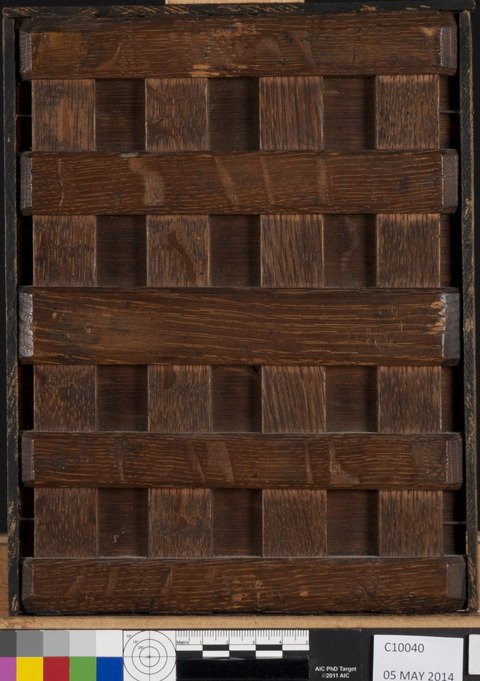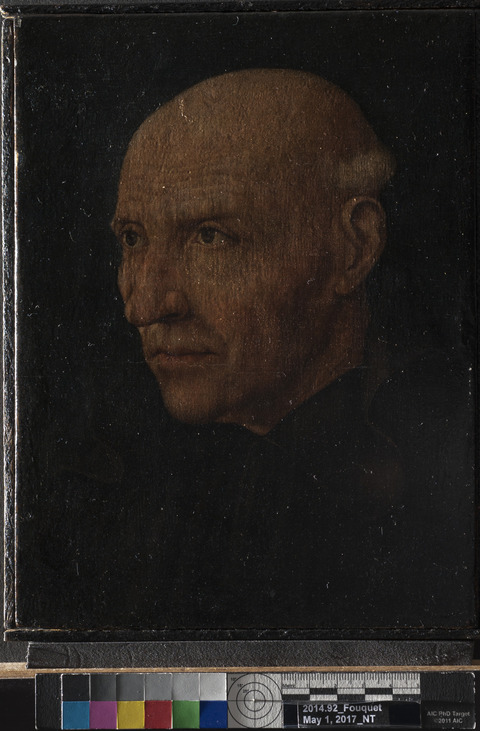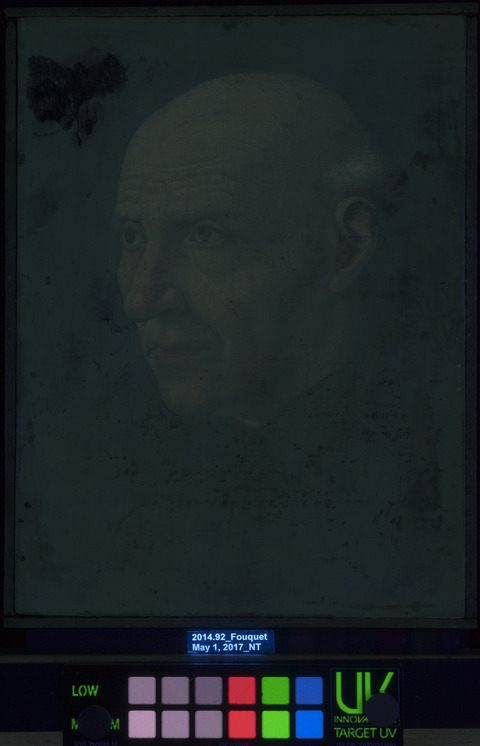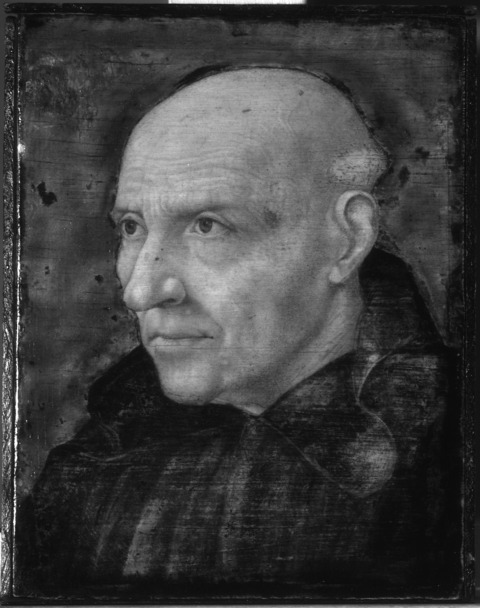Overview
Identification number: 2014.92
Artist: Unknown artist (possibly French?)
Title: Portrait of a Monk
Materials: Oil on oak panel
Date of creation: After about 1525
Previous number/accession number: C10040
Dimensions:
23 cm × 17.3 cm (panel)
23.8cm × 18.1 cm (including edge strips)
Conservator/examiner: Fiona Beckett with contributions from Roxane Sperber
Examination completed: June 2014, 2021
Distinguishing Marks
Front:
None
Back:
None
Summary of Treatment History
The painting has a long history of structural interventions that have altered the physical appearance of the object. The portrait may have been cut from a larger painting or donor portrait from an altarpiece. Additions are present on three of the four edges of the panel. A cradle on the back of the painting was likely added some time in the nineteenth or early twentieth century. Edge strips are nailed to the panel on all four sides. Extensive retouching on the surface suggests the painting has undergone numerous varnish removals and reintegration campaigns of lost and abraded paint.
In 1970, IMA curator A. Ian Fraser wrote to several scholars at the Louvre about their Portrait of Guillaume Jouvenel des Ursins requesting to investigate a possible connection between the works.1 A second letter from Fraser to Pierre Rosenberg notes “I have had a color sample made of the background color, and will bring it with me to Paris, so that we can check it against the background of your portrait."2
Documentation suggests a series of condition assessments and treatments were carried out on the collection around the time the works were moved from the Clowes' residence to the IMA in 1971. A condition report by Paul Spheeris in October of that year, likely carried out before the paintings were relocated, described the condition of the work as “O.K.,” but it was recommended that the painting receive immediate attention.3 A second condition assessment was carried out upon arrival of the paintings at the IMA. This assessment describes the work as having been received in good condition, and no treatment was recommended. An X-radiograph of the painting was made at this time.4
In 1974, a condition assessment, treatment, and investigation of the collection was carried out by the Intermuseum Conservation Association at Oberlin College. This document describes this painting as having a heavy, discolored natural resin varnish with disfiguring particles of gold leaf in it. It was recommended that the surface coating be removed, the cradle members be freed, and wax be applied to the back of the panel.5
A documented treatment from 1982 states that the painting was surface cleaned with water, the varnish was regenerated using propanol, and a new varnish layer of Paraloid B72 was applied.6 Dendrochronology was completed in July 1994 by Peter Klein.7 The dendrochronological analysis was revised by Ian Tyers in January 2019.8
The painting was previously examined and documented in the Clowes Collection annual survey from 2011 to 2020.
Current Condition Summary
Aesthetically, the painting is in fair condition. There are significant losses to the paint layer, and the discolored varnish obscures some of the original vibrancy of the colors. The painting is physically sound, with previous structural interventions intact.
Methods of Examination, Imaging, and Analysis
| Examination/Imaging | Analysis (no sample required) | Analysis (sample required) |
|---|---|---|
| Unaided eye | Dendrochronology | Microchemical analysis |
| Optical microscopy | Wood identification | Fiber ID |
| Incident light | Microchemical analysis | Cross-section sampling |
| Raking light | Thread count analysis | Dispersed pigment sample |
| Reflected/specular light | X-ray fluorescence spectroscopy (XRF) | Fourier-transform infrared spectroscopy (FTIR) |
| Transmitted light | Raman microspectroscopy | |
| Ultraviolet-induced visible fluorescence (UV) | ||
| Infrared reflectography (IRR) | Gas chromatography–mass spectrometry (GC-MS) | |
| Infrared transmittography (IRT) | Scanning electron microscope–energy dispersive X-ray spectroscopy (SEM-EDS) | |
| Infrared luminescence | Other: | |
| X-radiography |
TECHNICAL EXAMINATION
Description of Support
Analyzed Observed
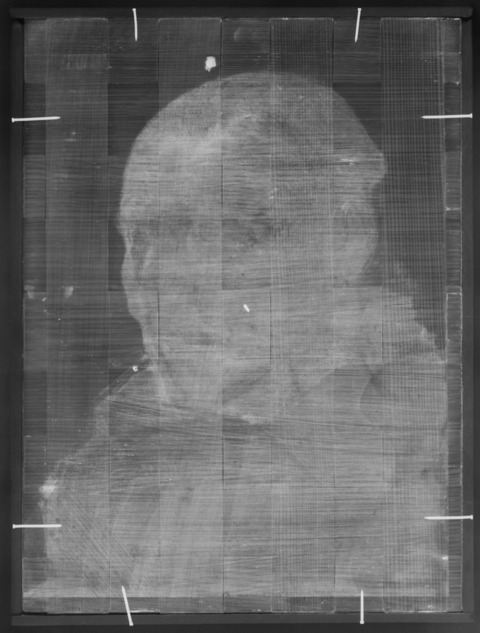
Material (fabric, wood, metal, dendrochronology results, fiber ID information, etc.):
Examination and dendrochronology of the panel was carried out by Ian Tyers in January 2019. The main board was derived from an exceptionally slow-growing eastern Baltic oak tree (tech. fig. 1). The latest ring present on the panel dates to 1517, confirming the tree was still growing in this year. Tyers suggests that for eastern Baltic sourced timber there are at least eight years of sapwood rings that are likely to be missing, suggesting the tree was felled after 1525 at the earliest. This provides a terminus post quem for the panel that is well outside the lifetime of Jean Fouquet (born about 1415–1420, died before 1481) to whom the painting was previously attributed. Further, the board is slightly narrower than is typical of many Baltic boards, suggesting that the outermost rings may have been trimmed during the construction of the panel. Additions on the top and bottom of the board further support this assertion (see Characteristics of Construction). The exceptionally slow growth of the tree means that even slight trimming could remove several decades of growth rings which would make the terminus post quem for the painting even later. Tyers also considers the possibility that the trimmed areas may have been partly or entirely sapwood, as sapwood is more vulnerable to decay and therefore may have prompted this area to require replacement.9
Characteristics of Construction / Fabrication (cusping, beveled edges of panels, seams, joins, battens):
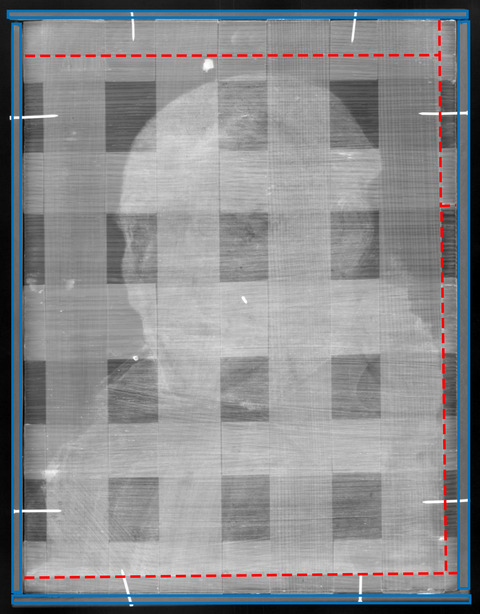
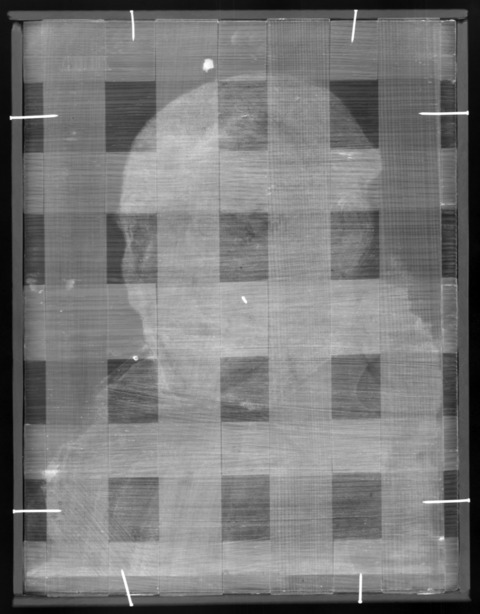
The panel is constructed of a single piece of oak with strips added to the top, bottom, and right edges of the panel (tech. fig. 2). The additions were almost certainly added later as the original paint layer does not extend onto these areas. The grain of the central panel, as well as the additions, is horizontally oriented. The grain of the main panel appears evenly spaced in the X-radiograph,10 and ray flecks are partially visible on the back of the panel suggesting it was radially cut.
Although not easy to decipher in the X-radiograph, a discontinuity in the panel can be seen along the top edge, at approximately the center of the top horizontal cradle member, indicating the presence of an addition.11 A second addition is also present on the right edge, just to the right of the right cradle member. This can be deciphered in the discontinuous wood grain between the main panel and right edge. The addition along the right edge is constructed from a long piece of wood that covers almost the full length of the right edge as well as a small piece at the bottom. This construction can be seen in technical figure 2 and is also visible in the infrared reflectogram (tech. fig. 5). A discontinuity in the wood is difficult to make out along the bottom addition, but broad brush stokes visible in the X-radiograph are abruptly cut off along the bottom edge (tech. fig. 3), suggesting this area of the panel was trimmed and the bottom section added. This was not noted by Tyers in his original report but was later confirmed.12
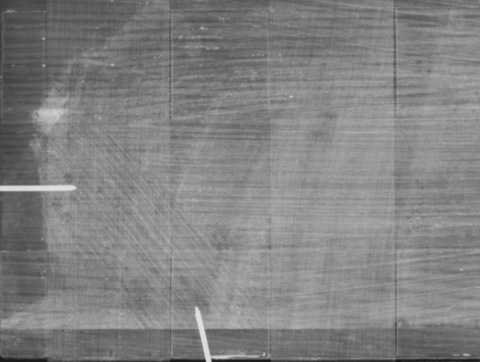
Thickness (for panels or boards):
2-3 mm
Production/Dealer’s Marks:
None
Auxiliary Support:
Original Not original Not able to discern None
The auxiliary support is a cradle with four vertical, movable members (all of which have seized) and five horizonal, fixed members. Edge strips are also present along all four edges.
Attachment to Auxiliary Support:
The cradle is glued to the back of the panel, securing it in place. Edge strips are nailed to all four sides of the panel, obscuring the original edges. Edge strips are secured in place by modern nails that are visible in the X-radiograph (tech. fig. 2).
Condition of Support
The support is in stable condition. The support was thinned before the addition of the cradle and shows some minor insect damage and some minor splitting. Warping of the panel has not occurred. This may be due to the cut of wood and the addition of the cradle.
Description of Ground
Analyzed Observed
Materials/Binding Medium:
Likely a chalk and glue ground.
Color:
The initial ground is an off-white color. It appears to have yellowed slightly over time.
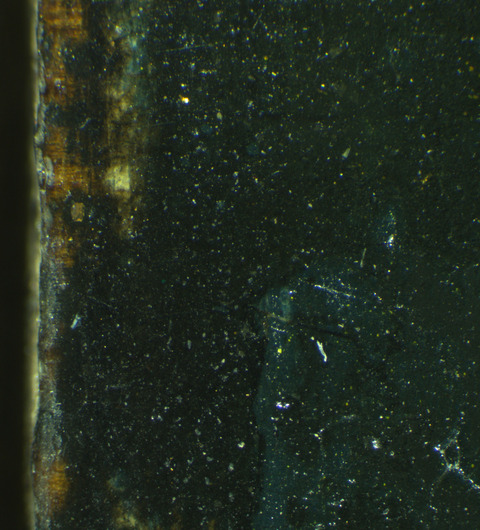
Application:
There appears to be a calcium-containing ground layer, which was likely applied to the entire surface of the panel, followed by an X-ray dense layer that was brushed with a large brush in sweeping strokes in different directions (see Description of Paint). The texture of this layer is visible on the panel when imaged with raking light.
Thickness:
The initial ground layer appears to be thinly applied. The ground is applied to the entire panel, but stops short before the left edge, as seen in technical figure 4. This indicates that the painting was likely not trimmed down on this side. It is possible that the unprimed edge was once intended to fit into an engaged frame. It is unclear whether the panel was intended to be the current dimensions or was at some point part of a larger panel or altarpiece.
Sizing:
A size layer would have been applied to the panel prior to the application of a ground layer.
Character and Appearance (Does texture of support remain detectable / prominent?):
The wood grain appears prominently through the paint layers and composition.
Condition of Ground
The ground appears to be in stable condition, and the adhesion between the ground layer and the panel remains intact. A natural aging crack network in the ground layer related to the wood grain is visible through the upper paint layers.
Description of Composition Planning
Methods of Analysis:
Surface observation (unaided or with magnification)
Infrared reflectography (IRR)
X-radiography
Analysis Parameters:
| X-radiography equipment | GE Inspection Technologies Type: ERESCO 200MFR 3.1, Tube S/N: MIR 201E 58-2812, EN 12543: 1.0mm, Filter: 0.8mm Be + 2mm Al |
|---|---|
| KV: | 26 |
| mA: | 3 |
| Exposure time (s) | 90 |
| Distance from x-ray tube: | 36” |
| IRR equipment and wavelength | Opus Instruments Osiris A1 infrared camera with InGaAs array detector operating at a wavelength of 0.9-1.7µm. |
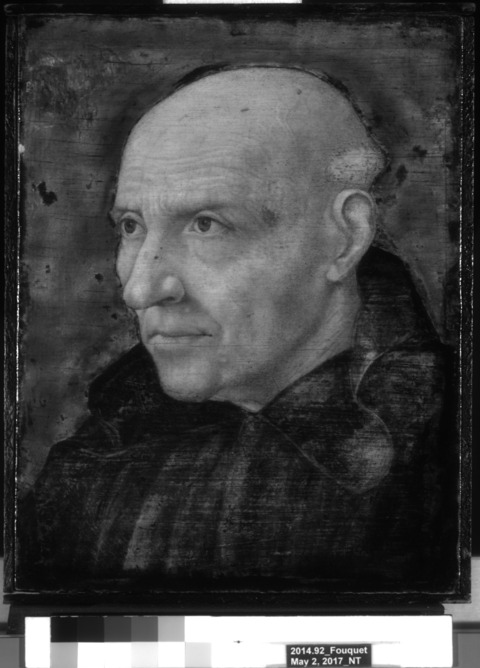
Medium/Technique:
Suggestions of underdrawing appear in the infrared reflectogram (tech. fig. 5), including in the chin and ear lobe. Much of what is visible in the IRR is also visible in visible light illumination. The medium was not identified, but it appears to be a fluid medium.
Pentimenti:
There are no pentimenti present in the infrared reflectogram. Slight reinforcements of the figure’s head and garment can be seen but appear to be executed during the painting process (tech. fig. 5). The ear appears to exhibit light underdrawing, though this is also visible under normal illumination (tech. fig. 6). It is possible that the panel was trimmed down to its current dimensions, and an addition was added to the top, right, and lower edges.
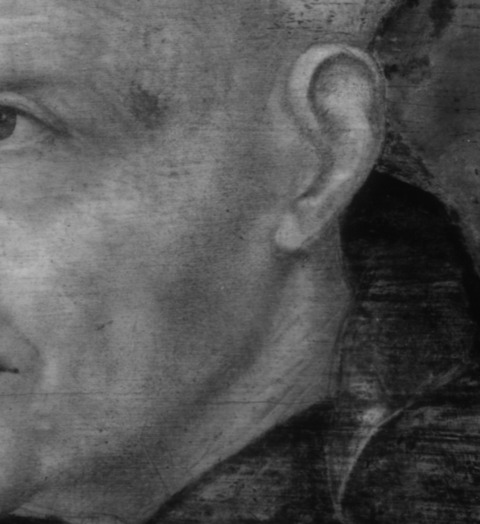
Description of Paint
Analyzed Observed
Application and Technique:
The X-radiograph shows the application of broad strokes of X-ray-absorbent paint, likely containing lead white, under the head and cloak of the figure (tech. fig. 2). These brushstrokes do not correspond to the upper layers of paint, nor are they consistent across the panel, suggesting that they do not correspond to the ground layer. Rather, they appear to be a “blocking out” layer that was applied under the area that was designated for the figure. Upper layers of paint were carefully applied in the face, showing the wrinkles, veins, and texture of the skin of the sitter. The robe is less detailed in its execution, but gentle folds are articulated using a range of black and brown tones to create form.
Painting Tools:
Brushes of varying sizes were used. There is no evidence of palette knife or other hard-edged tools.
Binding Media:
Oil (untested)
Color Palette:
The color palette is relatively simple and dark, comprised of a dark greenish-blue background, brown and black robes, and skin tones. When viewed under the microscope, the pigment combination in the background includes blues and greens. There are also a significant number of yellow pigment particles blended with the dark paint (tech. fig. 7). Given the presence of cobalt yellow in the background (table 1; sample 8, 10) this may be related to retouching applied using a still brush to “spritz” the surface.
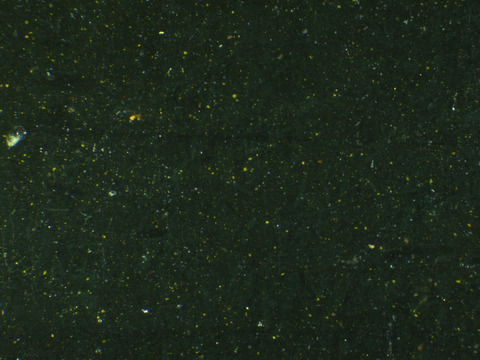
The border around the head forms a strong line, such that the head almost appears to float, compared to the dark background and robes. The detection of calcium throughout the painting through XRF analysis (see table 1, tech. fig. 8), suggests that a calcium ground layer is present. The skin tones comprise lead white, iron oxide (earth pigments including umber), vermilion, and a copper-containing blue and/or green pigment. Several modern pigments were detected in all three areas of the background, including strong peaks for zinc, cobalt, and in some locations, chromium. Damage visible in the infrared reflectogram suggests that this area may have been largely repainted. Strong peaks for iron in this area may be attributable to the presence of Prussian blue, although this cannot be confirmed using XRF. The blue-green appears to be a mixture of blue, green, and yellow pigments, as can be observed in microscopy (tech. fig. 7). Zinc was detected throughout the painting. This may be attributed to the presence of a zinc-rich ocher pigment or modern retouching using zinc white or zinc yellow.
XRF Analysis:
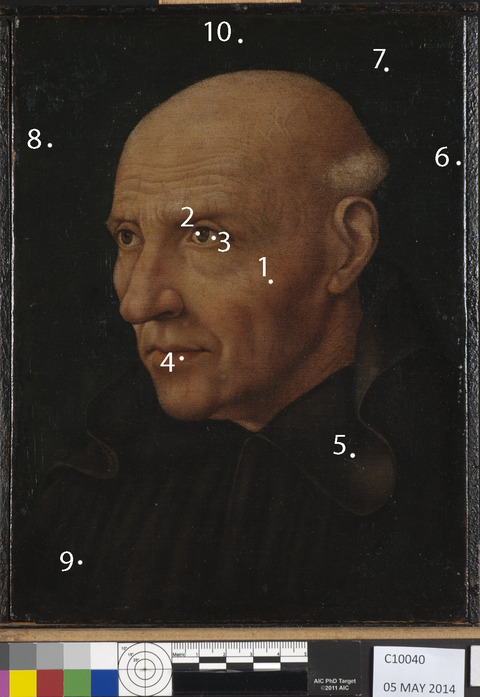
| Sample | Location (x, y) | Elements | Possible Pigments |
|---|---|---|---|
| 1 | Skin tone in face (cheek) | Major: Pb Minor: Fe Trace: Hg, Ca, Zn, Mn | Lead white, iron oxide (earth pigments), vermilion, calcium (likely from ground layer), small trace of zinc (from retouching and/or zinc-rich ocher). |
| 2 | Brown in eye | Major: Pb, Ca Minor: Zn, Fe Trace: | Lead white, calcium (likely from ground layer), iron oxide (earth pigments), zinc (from retouching and/or zinc-rich ocher). |
| 3 | White in eye | Major: Pb Minor: Ca Trace: Fe, Zn | Lead white, calcium (likely from ground layer), trace of iron oxide (earth pigments), small trace of zinc (from retouching and/or zinc-rich ocher). |
| 4 | Red in lips | Major: Pb Minor: Fe, Hg, Ca Trace: Cu, Zn, Mn | Lead white, vermilion, calcium (likely from ground layer), trace of iron oxide (earth pigments), small trace of zinc (from retouching and/or zinc-rich ocher), small trace of copper-containing blue and/or green pigment. |
| 5 | Brown-black in coat | Major: Pb, Ca Minor: Zn Trace: Fe, Mn, Cu, K | Lead white, calcium (likely from ground layer), zinc (possibly from retouching and/or zinc-rich ocher pigment), trace of iron oxide (earth pigments), small trace of copper-containing blue and/or green pigment. |
| 6 | Edge addition along right edge | Major: Ca, Zn Minor: Pb, Co, Fe, Trace: Cr, Mn, Ti, K, P | Calcium (likely from ground layer) and/or bone black, zinc white, lead white, cobalt yellow, iron oxide (earth pigments including umber), traces of chromium green, red and/or yellow, and trace of titanium white (or titanium from an impurity). |
| 7 | Blue-green background, right | Major: Zn, Fe, Co Minor: Mn, Ca, Pb Trace: K, Ti | Zinc white and/or yellow, cobalt yellow, iron oxide (earth pigment) and/or Prussian blue, lead white, calcium (likely from ground layer), trace of titanium white (or titanium from an impurity). |
| 8 | Blue-green background, left | Major: Ca Minor: Zn, Pb, Co, Fe Trace: Mn, Ti | Zinc white and/or yellow, cobalt yellow, iron oxide (earth pigment) and/or Prussian blue, lead white, calcium (likely from ground layer), trace of titanium white (or titanium from an impurity). |
| 9 | Garment, bottom left | Major: Pb Minor: Ca, Zn, Fe Trace: Cu, Mn | Lead white, calcium (likely from ground layer), zinc (from retouching and/or zinc-rich ocher), trace of iron oxide (earth pigments), small trace of copper-containing blue and/or green pigment. |
| 10 | Bluegreen background, top | Major: Zn Minor: Co, Fe, Pb, Ca Trace: Mn, Ti | Zinc white and/or yellow, cobalt yellow, iron oxide (earth pigment) and/or Prussian blue, lead white, calcium (likely from ground layer), trace of titanium white (or titanium from an impurity). |
Table 1: Results of X-ray fluorescence analysis conducted with a Bruker Artax microfocus XRF with rhodium tube, silicon-drift detector, and polycapillary focusing lens (~100μm spot).
*Major, minor, trace quantities are based on XRF signal strength not quantitative analysis
Surface Appearance:
The paint appears to be relatively thin, with no areas of impasto.
Condition of Paint
A micro cracking pattern from natural aging extends over the entire painting. Pinpoint paint losses are scattered throughout the painting. Some wear is visible around the perimeter of where the paint is in contact with the frame. Imbedded varnish and dirt cause the texture of the wood grain to appear more prominent than it once would have been. Some abrasion from previous cleaning is evident in the face and in the background. The background appears to have been significantly altered, possibly even largely removed, during a past intervention. Additionally, some lead soaps are present in the paint, emerging from the underlying lead white layer.
Description of Varnish/Surface Coating
Analyzed Observed Documented
| Type of Varnish | Application |
|---|---|
| Natural resin | Spray applied |
| Synthetic resin/other | Brush applied |
| Multiple Layers observed | Undetermined |
| No coating detected |
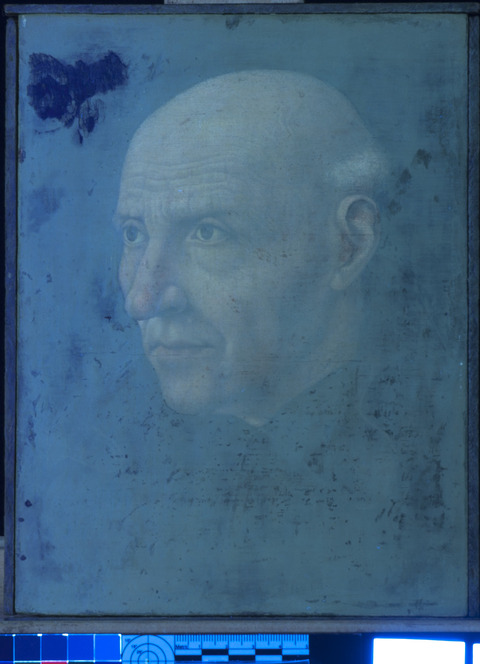
Ultraviolet-induced visible fluorescence reveals that there is a coating of natural resin varnish present over the entire surface of the painting (tech. fig. 9). The painting appears to be moderately yellowed. This was probably the varnish that was regenerated using propanol applied with a brush during the 1982 treatment. The treatment report also states that a spray varnish of 10% Paraloid B72 in xylene was applied at that time.13
There are several campaigns of retouching present including older restoration as well as that of a more recent retouching campaign. Not all the retouching is visible under ultraviolet-induced visible fluorescence, some is visible using microscopy. This suggests that much of the retouching is underneath the fluorescing layer of varnish. Much of the retouching is delicately applied, but there are a few areas of more extensive reconstruction, covering larger areas of loss and abrasion.
Condition of Varnish/Surface Coating
The varnish is moderately discolored, imparting a yellow tone to the painting. There are a few cloudy areas and some minor scuffs that look somewhat matte. Nevertheless, the painting is currently suitable for display. The retouching remains stable and well matched to the surrounding paint layer.
Description of Frame
| Original/first frame |
|---|
| Period frame |
| Authenticity cannot be determined at this time/ further art historical research necessary |
| Reproduction frame (fabricated in the style of) |
| Replica frame (copy of an existing period frame) |
| Modern Frame |
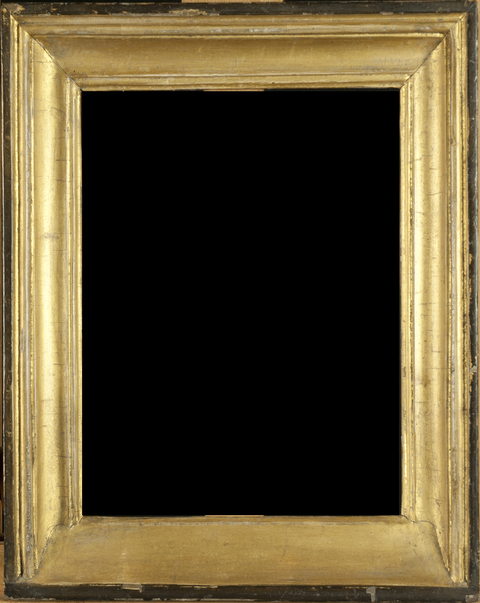

Frame Dimensions:
Outside frame dimensions: 31.1 × 24.7 × 3.9 cm
Sight size: 22.2 cm × 16.7 cm
Distinguishing Marks:
None
Description of Molding/Profile:
The frame appears to have oil gilding over a white gesso (tech. fig. 10). The corners are mitred from the front and have butt-joints on the back (tech. fig. 10, 11). The top and side members are more elaborately carved with ridges and a frieze, whereas the bottom member is very plain. Brown paint is present overtop of the gilding at the outer edes. According to the records at the Indianapolis Museum of Art, the frame was constructed and designed by frame specialist Timothy Newbery in the 1990s to house the painting more accurately.14
Condition of Frame
The frame is in relatively good condition and remains stable. There are several areas of abrasion and general wear, and quite a few losses are present in the brown paint along the edges. These are likely deliberate to simulate age and better suit the painting.
Notes
-
Letter from A. Ian Fraser to Madeleine Hours, 1 April 1970. Conservation Department Files, Indianapolis Museum of Art at Newfields. ↩︎
-
Letter from A. Ian Fraser to Pierre Rosenberg, 7 May 1970. Conservation Department Files, Indianapolis Museum of Art at Newfields. ↩︎
-
Paul A.J. Spheeris, “Conservation Report on the Condition of the Clowes Collection,” 25 October 1971, Conservation Department Files, Indianapolis Museum of Art at Newfields. ↩︎
-
Martin Radecki, Clowes Collection condition assessment, undated (after October 1971), Conservation Department Files, Indianapolis Museum of Art at Newfields. ↩︎
-
Intermuseum Conservation Association, “Clowes Collection Conservation Report,” C10040 (2014.92), 8–10 April 1974, Conservation Department Files, Indianapolis Museum of Art at Newfields. ↩︎
-
David Miller. Treatment report C10040 (2014.92), 14 Jan 1982. Conservation Department Files, Indianapolis Museum of Art at Newfields. ↩︎
-
Peter Klein, dendrochronological analysis report, C10040 (2014.92), 1999, Conservation Department Files, Indianapolis Museum of Art at Newfields. Klein offered an earlier date of creation based on his analysis. ↩︎
-
Ian Tyers, “Tree-Ring Analysis and Wood Identification of Paintings from the Indianapolis Museum of Art: Dendrochronological Consultancy Report 1082,” January 2019, p.14, Conservation Department files, Indianapolis Museum of Art at Newfields. ↩︎
-
Ian Tyers, “Tree-Ring Analysis and Wood Identification of Paintings from the Indianapolis Museum of Art,” Dendrochronological Consultancy Report 1082, January 2019, p. 14. Conservation Department files, Indianapolis Museum of Art at Newfields. ↩︎
-
Elvacite 2040 (synthetic resin) was used to fill the cradle while shooting the X-radiograph so that the appearance of the cradle would be minimized in the X-radiograph and allow the composition to be better interpreted. ↩︎
-
This discontinuity was noted by Ian Tyers in his report. Ian Tyers, “Tree-Ring Analysis and Wood Identification of Paintings from the Indianapolis Museum of Art,” Dendrochronological Consultancy Report 1082, January 2019, p. 14. Conservation Department files, Indianapolis Museum of Art at Newfields. ↩︎
-
Personal communication with Ian Tyers, email exchange, 20 May 2020. ↩︎
-
David Miller, Treatment report C10040 (2014.92), 14 January 1982, Conservation Department Files, Indianapolis Museum of Art at Newfields. ↩︎
-
Timothy Newbery. Frame Specialist, London England. Visual analysis completed at the Indianapolis Museum of Art, January 19 2012. ↩︎
Additional Images

